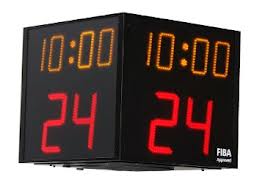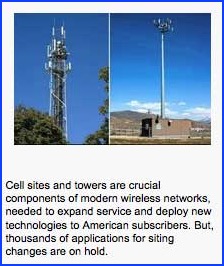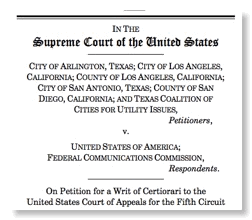CTIA & PCIA: With SCOTUS Review of FCC "Shot Clock" Decision Pending Shouldn't You Have a "Plan B"

Thanks to the Federal Communications Commission’s (FCC) 2009 shot clock ruling on tower siting, the number of cell sites continues to grow, which are key to providing wireless service in a geographic area. According to the semi-annual survey, there were 28,641 cell sites added this year for a total of 285,561 nationwide.
PCIA’s website and AT&T’s and Verizon’s policy blogs are also silent on the topic. Perhaps everyone is confident that the Supreme Court will uphold the FCC’s implementation of the shot clock rule - but then why did SCOTUS accept the case if it was so obvious?
Buildout of cellular infrastructure is the dominant source of wireless capacity growth despite the constant demands for new spectrum by the major carriers. This wireless capacity growth has numbers benefits for economic growth and international competitiveness. As Preston Marshall said recently at the recent Silicon Flatirons spectrum conference, if you increase mobile spectrum by 50% you basically increase mobile capacity by 50%, not 2000%. Thus timely buildout of infrastructure is key.
Why Does Infrastructure Have to Look Like it was “Designed by Engineers”?

Tip O’Neill famously said “all politics is local”. The cellular establishment no doubt feels that if they lose this case in the Supreme Court they can just pressure Congress to give them a more favorable law that avoids the problems of the present shot clock rule. Perhaps. But if Tip O’Neill is still correct, members of Congress may well be reluctant to pressure constituents to accept undesired cellular infrastructure in their immediate neighborhoods.
But perhaps the cellular establishment should listen to industry insiders like Previously I reported about the comments of Bechtel VP Jake MacLeod, when he stated at a 2009 FCC broadband hearing that “we have reached the end of the line for current design concepts (for cellular towers).” (Bechtel is a major builder of wireless infrastructure.) Or Alcatel-Lucent Wireless Division President Dr. Wim Sweldens who said
But we also have to be honest that in the mobile industry we are creating some problems. The mobile industry is actually contributing a fair amount to pollution...The mobile industry is also obstructing and cluttering our landscapes and cityscapes with more and more and bigger and bigger and uglier and uglier antennas and towers.
A major part of the opposition to infrastructure in suburbia is the inappropriate design that is normally used. If new design techniques could create the stealth bomber that could fly and be invisible to most radars, it is likely that a bold new design approach could develop new infrastructure designs that perform their intended function yet fit in better with their environment.
This was my point in point #5 of my suggested New Year’s Resolutions for the Cellular Industry - a set of topics that drew no interest from the intended audience.
So, CTIA and PCIA, you don’t have to call or contact me. But I sincerely hope that since an adverse SCOTUS decision in this case will hurt us all that you start thinking about a Plan B that does not just depend on lobbyists, but addresses the root design cause of your problem.
 .
.



![Validate my RSS feed [Valid RSS]](valid-rss-rogers.png)

